Syrian Civil War
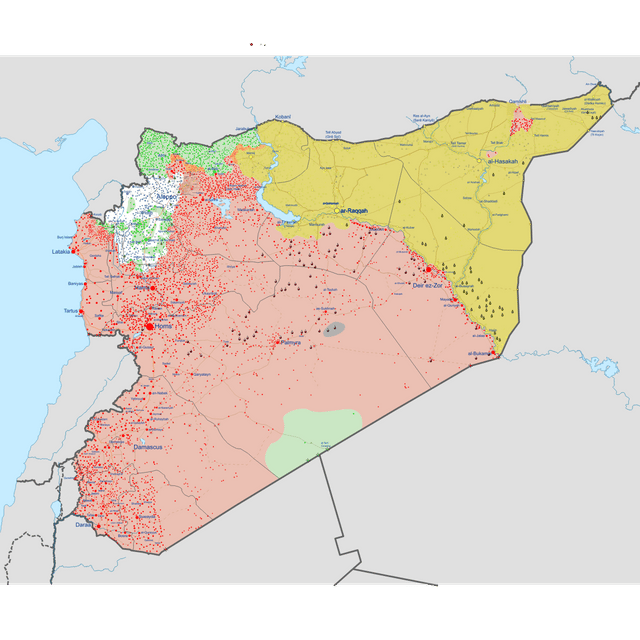
Syrian Civil War

| Syrian Civil War | |||||||||||
|---|---|---|---|---|---|---|---|---|---|---|---|
| Part of the Arab Spring, the Arab Winter, and the spillover of the Iraq conflict | |||||||||||
| |||||||||||
| Main belligerents | |||||||||||
|
(2016–present) Support:
Support:
| (2013–present) Support:
|
Support: | ||||||||
| Commanders and leaders | |||||||||||
Killed in action:
| Killed in action:
Killed in action:
|
Killed in action:
| |||||||||
| Units involved | |||||||||||
| See order | See order | See order | See order | ||||||||
| Strength | |||||||||||
| Syrian Armed Forces: 142,000(2019)[70] General Security Directorate: 8,000[71] National Defense Force: 80,000[72] Liwa Fatemiyoun: 10,000 – 20,000(2018)[73] Liwa Abu al-Fadhal al-Abbas: 10,000+(2013)[74] Ba'ath Brigades: 7,000 Hezbollah: 6,000–8,000[75] Liwa Al-Quds: 4,000–8,000 Russia: 4,000 troops[76] & 1,000 contractors[77] Iran: 3,000–5,000[75][78] Other allied groups: 20,000+ | Free Syrian Army: 20,000–32,000[79] (2013) Islamic Front: 40,000–70,000[80][81] (2014) Other groups: 12,500[82] (2015) Turkish Armed Forces: 4,000–8,000[83][84] Ahrar al-Sham: 18,000–20,000+[85][86] (March 2017) Tahrir al-Sham: 20,000-30,000(per U.S., late 2018)[87] | ~3,000(per Russia, mid 2019)[88][89] | SDF: 60,000–75,000(2017 est.)[90] | ||||||||
| Casualties and losses | |||||||||||
65,187–100,187 soldiers killed[96][97] 50,484–64,484 militiamen killed[96][97] 4,700 soldiers/militiamen & 2,000 supporters captured[96] 1,677–2,000 killed[96][98] 116 soldiers[99] & 186–280 PMCs killed[100] Other non-Syrian fighters: 8,109 killed[96] (2,300–3,500+ IRGC-led)[101][102] | 169 killed (2016–19 incursions)[103][104][105] | 28,532+ killed (per SOHR)[106] 20,711+ killed (per YPG & SAA)[107][108] | 11,600–12,586+ killed[109][110] 11 killed[111] | ||||||||
aSince early 2013, the FSA has been decentralized with its name being arbitrarily used by various rebels. bTurkey provided arms support to rebels since 2011 & since Aug. 2016 fought alongside the TFSA in the Aleppo governorate vs. the SDF, ISIL & Syrian gov. cSep.–Nov. 2016: U.S. fought with the TFSA in Aleppo governorate solely against ISIL.[114][115] In 2017–18, the U.S. purposely attacked the Syrian gov. 10 times, while in Sep. 2016 it accidentally hit a Syrian base, killing ≥100 SAA soldiers. Syria maintains this was intentional.[116] dPredecessors of HTS (al-Nusra Front) & ISIL (ISI) were allied al-Qaeda branches until April 2013. Al-Nusra Front rejected an ISI-proposed merger into ISIL & al-Qaeda cut all affiliation with ISIL in Feb. 2014. eAhrar al-Sham's predecessor, Syrian Liberation Front, and Tahrir al-Sham's predecessor, al-Nusra Front, were allied under the Army of Conquest from March 2015 to January 2017. fNumber includes Kurdish & ISIL fighters, whose deaths are also listed in their separate columns.[117][96] gIraq's involvement in Syria is limited to airstrikes against ISIL & are coordinated with the Syrian gov.[1] | |||||||||||
| Arab Ba'ath | 1940–1947 | ||||||||||
| Arab Ba'ath Movement | 1940–1947 | ||||||||||
| Ba'ath Party | 1947–1966 | ||||||||||
| Ba'ath Party (pro-Iraqi) | 1968–2003 | ||||||||||
| Ba'ath Party (pro-Syrian) | 1966–present | ||||||||||
| Algeria |
| ||||||||||
| Bahrain |
| ||||||||||
| Egypt |
| ||||||||||
| Iraq |
| ||||||||||
| Jordan |
| ||||||||||
| Kuwait |
| ||||||||||
| Lebanon |
| ||||||||||
| Libya |
| ||||||||||
| Mauritania |
| ||||||||||
| Palestine |
| ||||||||||
| Sudan |
| ||||||||||
| Syria |
| ||||||||||
| Tunisia |
| ||||||||||
| Yemen |
| ||||||||||
| Arab Socialist Revolutionary Ba'ath Party | 1960–1962/63 | ||||||||||
| Socialist Lebanon | 1965–1970 | ||||||||||
| Arab Revolutionary Workers Party | 1966–present | ||||||||||
| Democratic Socialist Arab Ba'ath Party | 1970–present | ||||||||||
| Sudanese Ba'ath Party | 2002–present | ||||||||||
 | |||||||||||
| Population 21 ±.5: Displaced 6 ±.5, Refugee 5.5 ±.5, Casualty 0.5 ±.1 (millions) | |||||||||||
| Syrian Refugees | |||||||||||
| By Country | Turkey, Lebanon, Jordan, Egypt | ||||||||||
| Settlements | Camps: (Jordan) | ||||||||||
| Displaced Syrians | |||||||||||
| De-escalation | Safe zone | ||||||||||
| Casualties of Conflict | |||||||||||
| Crimes | Human rights violations, Massacres, Rape | ||||||||||
| Return of Refugees**·Refugees as weapons·**Prosecution of War criminals | |||||||||||
The Syrian Civil War (Arabic: الحرب الأهلية السورية, al-ḥarb al-ʾahlīyah as-sūrīyah) is an ongoing multi-sided civil war in Syria fought between the Ba'athist Syrian Arab Republic led by President Bashar al-Assad, along with domestic and foreign allies, and various domestic and foreign forces opposing both the Syrian government and each other in varying combinations.[118] The war is currently the second deadliest of the 21st century.[119]
The unrest in Syria, part of a wider wave of the 2011 Arab Spring protests, grew out of discontent with the Syrian government and escalated to an armed conflict after protests calling for Assad's removal were violently suppressed.[120][121] The war, which began on 15 March with major unrest in Damascus and Aleppo,[122] is being fought by several factions: the Syrian Armed Forces and its international allies, a loose alliance of mostly Sunni opposition rebel groups (including the Free Syrian Army), Salafi jihadist groups (including al-Nusra Front), the mixed Kurdish-Arab Syrian Democratic Forces (SDF), and the Islamic State of Iraq and the Levant (ISIL), with a number of countries in the region and beyond being either directly involved or providing support to one or another faction (Iran, Russia, Turkey, the United States, as well as others).
Iran, Russia, and Hezbollah support the Syrian Arab Republic and the Syrian Armed Forces militarily, with Russia conducting airstrikes and other military operations since September 2015. The U.S.-led international coalition, established in 2014 with the declared purpose of countering ISIL, has conducted airstrikes primarily against ISIL as well as some against government and pro-government targets. They have also deployed special forces and artillery units to engage ISIL on the ground. Since 2015, the U.S. has supported the Democratic Federation of Northern Syria and its armed wing, the SDF, materially, financially, and logistically. Turkey is directly involved in operations against the Syrian government since August 2016, not only participating in airstrikes against ISIL alongside the U.S.-led coalition, but also actively supporting the Syrian opposition and occupying large swaths of northwestern Syria while engaging in significant ground combat with ISIL, the SDF, and the Syrian government. Between 2011 and 2017, fighting from the Syrian Civil War spilled over into Lebanon as opponents and supporters of the Syrian government traveled to Lebanon to fight and attack each other on Lebanese soil, with ISIL and Al-Nusra also engaging the Lebanese Army. Furthermore, while officially neutral, Israel has conducted airstrikes against Hezbollah and Iranian forces, whose presence in southwestern Syria it views as a threat.[123]
International organizations have accused virtually all sides involved, including the Ba'athist Syrian government, ISIL, opposition rebel groups, Russia,[124] and the U.S.-led coalition[125] of severe human rights violations and massacres.[126] The conflict has caused a major refugee crisis. Over the course of the war, a number of peace initiatives have been launched, including the March 2017 Geneva peace talks on Syria led by the United Nations, but fighting continues.[127]
| Syrian Civil War | |||||||||||
|---|---|---|---|---|---|---|---|---|---|---|---|
| Part of the Arab Spring, the Arab Winter, and the spillover of the Iraq conflict | |||||||||||
| |||||||||||
| Main belligerents | |||||||||||
|
(2016–present) Support:
Support:
| (2013–present) Support:
|
Support: | ||||||||
| Commanders and leaders | |||||||||||
Killed in action:
| Killed in action:
Killed in action:
|
Killed in action:
| |||||||||
| Units involved | |||||||||||
| See order | See order | See order | See order | ||||||||
| Strength | |||||||||||
| Syrian Armed Forces: 142,000(2019)[70] General Security Directorate: 8,000[71] National Defense Force: 80,000[72] Liwa Fatemiyoun: 10,000 – 20,000(2018)[73] Liwa Abu al-Fadhal al-Abbas: 10,000+(2013)[74] Ba'ath Brigades: 7,000 Hezbollah: 6,000–8,000[75] Liwa Al-Quds: 4,000–8,000 Russia: 4,000 troops[76] & 1,000 contractors[77] Iran: 3,000–5,000[75][78] Other allied groups: 20,000+ | Free Syrian Army: 20,000–32,000[79] (2013) Islamic Front: 40,000–70,000[80][81] (2014) Other groups: 12,500[82] (2015) Turkish Armed Forces: 4,000–8,000[83][84] Ahrar al-Sham: 18,000–20,000+[85][86] (March 2017) Tahrir al-Sham: 20,000-30,000(per U.S., late 2018)[87] | ~3,000(per Russia, mid 2019)[88][89] | SDF: 60,000–75,000(2017 est.)[90] | ||||||||
| Casualties and losses | |||||||||||
65,187–100,187 soldiers killed[96][97] 50,484–64,484 militiamen killed[96][97] 4,700 soldiers/militiamen & 2,000 supporters captured[96] 1,677–2,000 killed[96][98] 116 soldiers[99] & 186–280 PMCs killed[100] Other non-Syrian fighters: 8,109 killed[96] (2,300–3,500+ IRGC-led)[101][102] | 169 killed (2016–19 incursions)[103][104][105] | 28,532+ killed (per SOHR)[106] 20,711+ killed (per YPG & SAA)[107][108] | 11,600–12,586+ killed[109][110] 11 killed[111] | ||||||||
aSince early 2013, the FSA has been decentralized with its name being arbitrarily used by various rebels. bTurkey provided arms support to rebels since 2011 & since Aug. 2016 fought alongside the TFSA in the Aleppo governorate vs. the SDF, ISIL & Syrian gov. cSep.–Nov. 2016: U.S. fought with the TFSA in Aleppo governorate solely against ISIL.[114][115] In 2017–18, the U.S. purposely attacked the Syrian gov. 10 times, while in Sep. 2016 it accidentally hit a Syrian base, killing ≥100 SAA soldiers. Syria maintains this was intentional.[116] dPredecessors of HTS (al-Nusra Front) & ISIL (ISI) were allied al-Qaeda branches until April 2013. Al-Nusra Front rejected an ISI-proposed merger into ISIL & al-Qaeda cut all affiliation with ISIL in Feb. 2014. eAhrar al-Sham's predecessor, Syrian Liberation Front, and Tahrir al-Sham's predecessor, al-Nusra Front, were allied under the Army of Conquest from March 2015 to January 2017. fNumber includes Kurdish & ISIL fighters, whose deaths are also listed in their separate columns.[117][96] gIraq's involvement in Syria is limited to airstrikes against ISIL & are coordinated with the Syrian gov.[1] | |||||||||||
| Arab Ba'ath | 1940–1947 | ||||||||||
| Arab Ba'ath Movement | 1940–1947 | ||||||||||
| Ba'ath Party | 1947–1966 | ||||||||||
| Ba'ath Party (pro-Iraqi) | 1968–2003 | ||||||||||
| Ba'ath Party (pro-Syrian) | 1966–present | ||||||||||
| Algeria |
| ||||||||||
| Bahrain |
| ||||||||||
| Egypt |
| ||||||||||
| Iraq |
| ||||||||||
| Jordan |
| ||||||||||
| Kuwait |
| ||||||||||
| Lebanon |
| ||||||||||
| Libya |
| ||||||||||
| Mauritania |
| ||||||||||
| Palestine |
| ||||||||||
| Sudan |
| ||||||||||
| Syria |
| ||||||||||
| Tunisia |
| ||||||||||
| Yemen |
| ||||||||||
| Arab Socialist Revolutionary Ba'ath Party | 1960–1962/63 | ||||||||||
| Socialist Lebanon | 1965–1970 | ||||||||||
| Arab Revolutionary Workers Party | 1966–present | ||||||||||
| Democratic Socialist Arab Ba'ath Party | 1970–present | ||||||||||
| Sudanese Ba'ath Party | 2002–present | ||||||||||
 | |||||||||||
| Population 21 ±.5: Displaced 6 ±.5, Refugee 5.5 ±.5, Casualty 0.5 ±.1 (millions) | |||||||||||
| Syrian Refugees | |||||||||||
| By Country | Turkey, Lebanon, Jordan, Egypt | ||||||||||
| Settlements | Camps: (Jordan) | ||||||||||
| Displaced Syrians | |||||||||||
| De-escalation | Safe zone | ||||||||||
| Casualties of Conflict | |||||||||||
| Crimes | Human rights violations, Massacres, Rape | ||||||||||
| Return of Refugees**·Refugees as weapons·**Prosecution of War criminals | |||||||||||
Background
Assad government
The secular Ba'ath Syrian Regional Branch government came to power through a successful coup d'état in 1963. For several years Syria went through additional coups and changes in leadership,[128] until in March 1971, Hafez al-Assad, an Alawite, declared himself President. The secular Syrian Regional Branch remained the dominant political authority in what had been a one-party state until the first multi-party election to the People's Council of Syria was held in 2012.[129] On 31 January 1973, Hafez al-Assad implemented a new constitution, which led to a national crisis. Unlike previous constitutions, this one did not require that the president of Syria be a Muslim, leading to fierce demonstrations in Hama, Homs and Aleppo organized by the Muslim Brotherhood and the ulama. The government survived a series of armed revolts by Islamists, mainly members of the Muslim Brotherhood, from 1976 until 1982.
Upon Hafez al-Assad's death in 2000, his son Bashar al-Assad was elected as President of Syria. Bashar and his wife Asma, a Sunni Muslim born and educated in Britain,[130] initially inspired hopes for democratic reforms; however, according to his critics, Bashar failed to deliver on promised reforms.[131] President Al-Assad maintained in 2017 that no 'moderate opposition' to his rule exists, and that all opposition forces are jihadists intent on destroying his secular leadership; his view was that terrorist groups operating in Syria are 'linked to the agendas of foreign countries'.[132]
Demographics
The total population in July 2018 was estimated at 19,454,263 people; ethnic groups – approximately Arab 50%, Alawite 15%, Kurd 10%, Levantine 10%, other 15% (includes Druze, Ismaili, Imami, Nusairi, Assyrian, Turkmen, Armenian); religions – Muslim 87% (official; includes Sunni 74% and Alawi, Ismaili, and Shia 13%), Christian 10% (mainly of Eastern Christian churches[133] – may be smaller as a result of Christians fleeing the country), Druze 3%, Jewish (few remaining in Damascus and Aleppo).[134]
Socioeconomic background
Socioeconomic inequality increased significantly after free market policies were initiated by Hafez al-Assad in his later years, and it accelerated after Bashar al-Assad came to power. With an emphasis on the service sector, these policies benefited a minority of the nation's population, mostly people who had connections with the government, and members of the Sunni merchant class of Damascus and Aleppo.[135] In 2010, Syria's nominal GDP per capita was only $2,834, comparable to Sub-Saharan African countries such as Nigeria and far lower than its neighbors such as Lebanon, with an annual growth rate of 3.39%, below most other developing countries.[136]
The country also faced particularly high youth unemployment rates.[137] At the start of the war, discontent against the government was strongest in Syria's poor areas, predominantly among conservative Sunnis.[135] These included cities with high poverty rates, such as Daraa and Homs, and the poorer districts of large cities.
Drought
This coincided with the most intense drought ever recorded in Syria, which lasted from 2006 to 2011 and resulted in widespread crop failure, an increase in food prices and a mass migration of farming families to urban centers.[138] This migration strained infrastructure already burdened by the influx of some 1.5 million refugees from the Iraq War.[139] The drought has been linked to anthropogenic global warming.[140][141][142] Adequate water supply continues to be an issue in the ongoing civil war and it is frequently the target of military action.[143]
Human rights
The human rights situation in Syria has long been the subject of harsh critique from global organizations.[144] The rights of free expression, association and assembly were strictly controlled in Syria even before the uprising.[145] The country was under emergency rule from 1963 until 2011 and public gatherings of more than five people were banned.[146] Security forces had sweeping powers of arrest and detention.[147] Despite hopes for democratic change with the 2000 Damascus Spring, Bashar al-Assad was widely regarded as having failed to implement any improvements. A Human Rights Watch report issued just before the beginning of the 2011 uprising stated that he had failed to substantially improve the state of human rights since taking power.[148]
Timeline
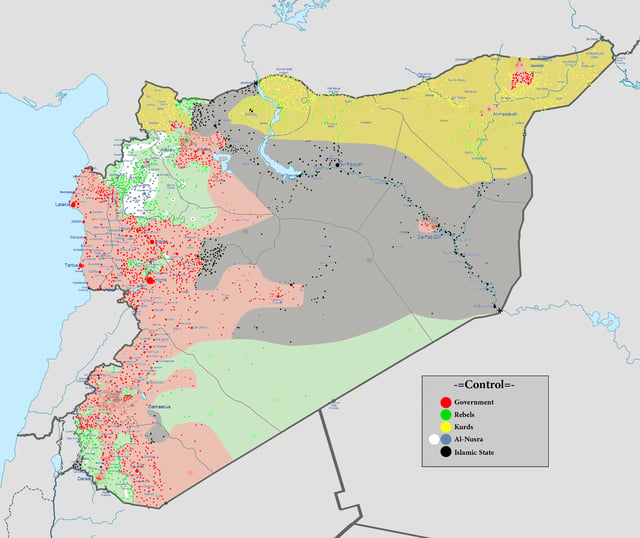
Military situation in August 2016
Protests, civil uprising, and defections (March–July 2011)
Initial armed insurgency (July 2011 – April 2012)
Kofi Annan ceasefire attempt (April–May 2012)
Third phase of the war starts: escalation (2012–2013))
Rise of the Islamist groups (January–September 2014)
US intervention (September 2014 – September 2015)
Russian intervention (September 2015 – March 2016), including first partial ceasefire
Aleppo recaptured; Russian/Iranian/Turkish-backed ceasefire (December 2016 – April 2017)
Syrian-American conflict; de-escalation Zones (April 2017 – June 2017)
ISIL siege of Deir ez-Zor broken; CIA program halted; Russian forces permanent (July 2017–Dec. 2017)
Army advance in Hama province and Ghouta; Turkish intervention in Afrin (January–March 2018)
Douma chemical attack; U.S.-led missile strikes; Southern Syria offensive (April 2018 – August 2018)
Idlib demilitarization; Trump announces US withdrawal; Iraq strikes ISIL targets (September–December 2018)
ISIL attacks continue; US states conditions of withdrawal; Fifth inter-rebel conflict (January–May 2019)
Demilitarization agreement falls apart; 2019 Northwestern Syria offensive; Northern Syria Buffer Zone established (May 2019 – Present)
Belligerents
There are numerous factions, both foreign and domestic, involved in the Syrian Civil War, including ISIL,[149] the Turkish-backed Free Syrian Army,[150] pro-government Christian militias,[151] al-Qaeda in Syria,[152] Kurdish-dominated YPG militia,[153] or Shia sectarian militias from Iran, Iraq and Afghanistan, many of whom are aligned against each other. Both the Syrian government and the opposition have received support, militarily and diplomatically, from foreign countries leading the conflict to often be described as a proxy war.[154]
Foreign involvement
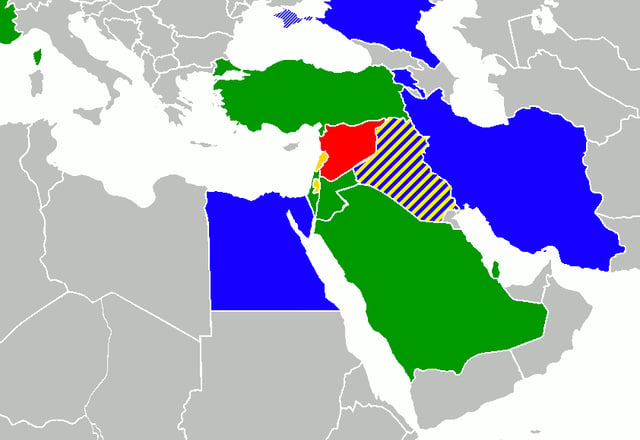
Map of countries surrounding Syria (red) with military involvement Countries that support the Syrian government Countries that support the Syrian rebels Countries that are divided in their support
The major parties supporting the Syrian Government are Iran,[155] Russia[151] and the Lebanese Hezbollah. Syrian rebel groups received political, logistic and military support from the United States,[156][157] Turkey,[158] Saudi Arabia,[159] Qatar,[160] Britain, France,[161] Israel and the Netherlands.[162][163] Under the aegis of operation Timber Sycamore and other clandestine activities, CIA operatives and U.S. special operations troops have trained and armed nearly 10,000 rebel fighters at a cost of $1 billion a year since 2012.[164]
Spillover
In June 2014, members of the Islamic State of Iraq and the Levant (ISIL) crossed the border from Syria into northern Iraq, and took control of large swaths of Iraqi territory as the Iraqi Army abandoned its positions. Fighting between rebels and government forces also spilled over into Lebanon on several occasions. There were repeated incidents of sectarian violence in the North Governorate of Lebanon between supporters and opponents of the Syrian government, as well as armed clashes between Sunnis and Alawites in Tripoli.[165]
Starting on 5 June 2014, ISIL seized swathes of territory in Iraq. As of 2014, the Syrian Arab Air Force used airstrikes targeted against ISIL in Raqqa and al-Hasakah in coordination with the Iraqi government.[166]
Advanced weaponry and tactics
Destruction of chemical weapons
Sarin, mustard agent and chlorine gas have been used during the conflict. Numerous casualties led to an international reaction, especially the 2013 Ghouta attacks. A UN fact-finding mission was requested to investigate alleged chemical weapons attacks. In four cases UN inspectors confirmed the use of sarin gas.[167] In August 2016, a confidential report by the United Nations and the OPCW explicitly blamed the Syrian military of Bashar al-Assad for dropping chemical weapons (chlorine bombs) on the towns of Talmenes in April 2014 and Sarmin in March 2015 and ISIS for using sulfur mustard on the town of Marea in August 2015.[168]
The United States and the European Union have accused the Syrian government of conducting several chemical attacks. Following the 2013 Ghouta attacks and international pressure, the destruction of Syria's chemical weapons began. In 2015 the UN mission disclosed previously undeclared traces of sarin compounds in a "military research site".[169] After the April 2017 Khan Shaykhun chemical attack, the United States launched its first attack against Syrian government forces.
In June 2019, United States Deputy Assistant Secretary of Defense Michael Mulroy stated that the United States “will respond quickly and appropriately,” if the regime uses chemical weapons again. He added that Bashar al-Assad has done more than any other to destabilize the region by "murdering his own people" and that both Russia and the Syrian regime have shown no concern for the suffering of the Syrian people creating one of the "worst humanitarian tragedies in history".[170]
Cluster bombs
Syria is not parties to the Convention on Cluster Munitions and does not recognize the ban on the use of cluster bombs. The Syrian Army is alleged to have begun using cluster bombs in September 2012. Steve Goose, director of the Arms Division at Human Rights Watch said "Syria is expanding its relentless use of cluster munitions, a banned weapon, and civilians are paying the price with their lives and limbs", "The initial toll is only the beginning because cluster munitions often leave unexploded bomblets that kill and maim long afterward."[171]
Thermobaric weapons
Russian thermobaric weapons, also known as "fuel-air bombs", have been used by the government side during the war. On 2 December 2015, The National Interest reported that Russia was deploying the TOS-1 Buratino multiple rocket launch system to Syria, which is "designed to launch massive thermobaric charges against infantry in confined spaces such as urban areas."[172] One Buratino thermobaric rocket launcher "can obliterate a roughly 200 by 400 metres (660 by 1,310 feet) area with a single salvo".[173] Since 2012, rebels have said that the Syrian Air Force (government forces) is using thermobaric weapons against residential areas occupied by the rebel fighters, such as during the Battle of Aleppo and also in Kafr Batna.[174] A panel of United Nations human rights investigators reported that the Syrian government used thermobaric bombs against the strategic town of Qusayr in March 2013.[175] In August 2013, the BBC reported on the use of napalm-like incendiary bombs on a school in northern Syria.[176]
Anti-tank missiles

An Army of Glory fighter launches a BGM-71 TOW anti-tank missile at a Syrian government position during the 2017 Hama offensive.
Several types of anti-tank missiles are in use in Syria. Russia has sent 9M133 Kornet, third-generation anti-tank guided missiles to the Syrian Government whose forces have used them extensively against armour and other ground targets to fight Jihadists and rebels.[177] U.S.-made BGM-71 TOW missiles are one of the primary weapons of rebel groups and have been primarily provided by the United States and Saudi Arabia.[178] The U.S. has also supplied many Eastern European sourced 9K111 Fagot launchers and warheads to Syrian rebel groups under its Timber Sycamore program.[179]
Ballistic missiles
Media coverage
The Syrian Civil War is one of the most heavily documented wars in history, despite the extreme dangers that journalists face while in Syria.[182]
ISIL and al-Qaeda executions
On 19 August, American journalist James Foley was executed by ISIL, who claimed it was in retaliation for the United States operations in Iraq. Foley was kidnapped in Syria in November 2012 by Shabiha militia.[183] ISIL also threatened to execute Steven Sotloff, who was kidnapped at the Syrian-Turkish border in August 2013.[184] There were reports ISIS captured a Japanese national, two Italian nationals, and a Danish national as well.[185] Sotloff was later executed in September 2014. At least 70 journalists have been killed covering the Syrian war, and more than 80 kidnapped, according to the Committee to Protect Journalists.[186] On 22 August 2014, the al-Nusra Front released a video of captured Lebanese soldiers and demanded Hezbollah withdraw from Syria under threat of their execution.[187]
International reactions
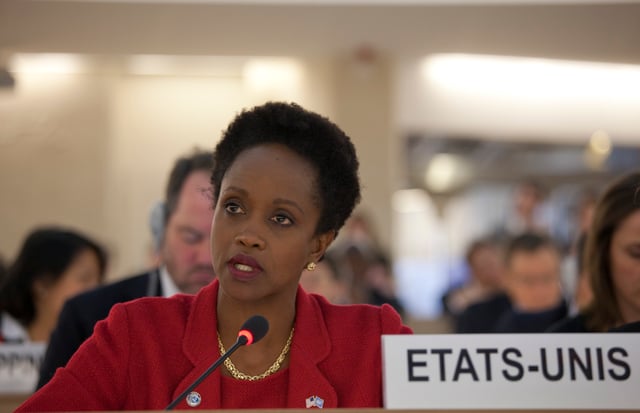
Esther Brimmer (U.S.) speaks at a United Nations Human Rights Council urgent debate on Syria, February 2012
During the early period of the civil war, The Arab League, European Union, the United Nations,[188] and many Western governments quickly condemned the Syrian government's violent response to the protests, and expressed support for the protesters' right to exercise free speech.[189] Initially, many Middle Eastern governments expressed support for Assad, but as the death toll mounted, they switched to a more balanced approach by criticizing violence from both government and protesters. Both the Arab League and the Organisation of Islamic Cooperation suspended Syria's membership. Russia and China vetoed Western-drafted United Nations Security Council resolutions in 2011 and 2012, which would have threatened the Syrian government with targeted sanctions if it continued military actions against protestors.[190]
Sectarian threats
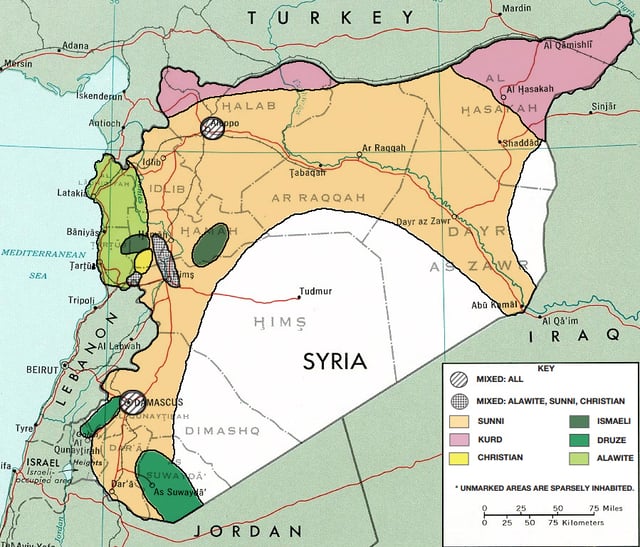
Map of Syria's ethno-religious composition in 1976
The successive governments of Hafez and Bashar al-Assad have been closely associated with the country's minority Alawite religious group,[191] an offshoot of Shia, whereas the majority of the population, and most of the opposition, is Sunni. Alawites started to be threatened and attacked by dominantly Sunni rebel fighting groups like al-Nusra Front and the FSA since December 2012 (see Sectarianism and minorities in the Syrian Civil War#Alawites).
Many Syrian Christians reported that they had fled after they were targeted by the anti-government rebels.[194] (See: Sectarianism and minorities in the Syrian Civil War#Christians.)
Al Jazeera reported that "The Druze accuse rebels of committing atrocities against their community in Syria ... Syria's Druze minority has largely remained loyal to President Bashar al-Assad since the war began in 2011."[195]
As militias and non-Syrian Shia—motivated by pro-Shia sentiment rather than loyalty to the Assad government—have taken over fighting the opposition from the weakened Syrian Army, fighting has taken on a more sectarian nature. One opposition leader has alleged that the Shia militias often "try to occupy and control the religious symbols in the Sunni community to achieve not just a territorial victory but a sectarian one as well"[196]—allegedly occupying mosques and replacing Sunni icons with pictures of Shia leaders.[196]
According to the Syrian Network for Human Rights human rights abuses have been committed by the militias including "a series of sectarian massacres between March 2011 and January 2014 that left 962 civilians dead".[196]
Crime wave
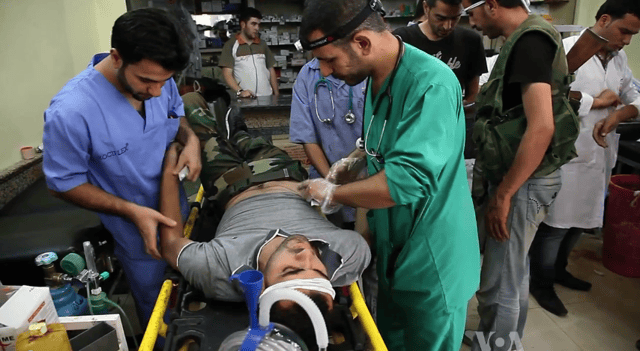
Doctors and medical staff treating injured rebel fighters and civilians in Aleppo
As the conflict has expanded across Syria, many cities have been engulfed in a wave of crime as fighting caused the disintegration of much of the civilian state, and many police stations stopped functioning. Rates of theft increased, with criminals looting houses and stores. Rates of kidnappings increased as well. Rebel fighters were seen stealing cars and, in one instance, destroying a restaurant in Aleppo where Syrian soldiers had been seen eating.[197]
Local National Defense Forces commanders often engaged "in war profiteering through protection rackets, looting, and organized crime". NDF members were also implicated in "waves of murders, robberies, thefts, kidnappings, and extortions throughout government-held parts of Syria since the formation of the organization in 2013", as reported by the Institute for the Study of War.[198]
Criminal networks have been used by both the government and the opposition during the conflict. Facing international sanctions, the Syrian government relied on criminal organizations to smuggle goods and money in and out of the country. The economic downturn caused by the conflict and sanctions also led to lower wages for Shabiha members. In response, some Shabiha members began stealing civilian properties and engaging in kidnappings.[199] Rebel forces sometimes rely on criminal networks to obtain weapons and supplies. Black market weapon prices in Syria's neighboring countries have significantly increased since the start of the conflict. To generate funds to purchase arms, some rebel groups have turned towards extortion, theft, and kidnapping.[199]
Cultural heritage

The Temple of Bel in Palmyra, which was destroyed by ISIL in August 2015
In January 2018 Turkish air strikes have seriously damaged an ancient Neo-Hittite temple in Syria's Kurdish-held Afrin region. It was built by the Arameans in the first millennium BC.[200]
As of March 2015, the war has affected 290 heritage sites, severely damaged 104, and completely destroyed 24. Five of the six UNESCO World Heritage Sites in Syria have been damaged.[201] Destruction of antiquities has been caused by shelling, army entrenchment, and looting at various tells, museums, and monuments.[202] A group called Syrian Archaeological Heritage Under Threat is monitoring and recording the destruction in an attempt to create a list of heritage sites damaged during the war and to gain global support for the protection and preservation of Syrian archaeology and architecture.[203]
UNESCO listed all six Syria's World Heritage sites as endangered but direct assessment of damage is not possible. It is known that the Old City of Aleppo was heavily damaged during battles being fought within the district, while Palmyra and Krak des Chevaliers suffered minor damage. Illegal digging is considered a grave danger, and hundreds of Syrian antiquities, including some from Palmyra, appeared in Lebanon. Three archeological museums are known to have been looted; in Raqqa some artifacts seem to have been destroyed by foreign Islamists due to religious objections.[204]
In 2014 and 2015, following the rise of the Islamic State of Iraq and the Levant, several sites in Syria were destroyed by the group as part of a deliberate destruction of cultural heritage sites. In Palmyra, the group destroyed many ancient statues, the Temples of Baalshamin and Bel, many tombs including the Tower of Elahbel, and part of the Monumental Arch.[205] The 13th-century Palmyra Castle was extensively damaged by retreating militants during the Palmyra offensive in March 2016.[206] ISIL also destroyed ancient statues in Raqqa,[207] and a number of churches, including the Armenian Genocide Memorial Church in Deir ez-Zor.[208]
According to a September 2019 Syrian Network for Human Rights reports more than 120 Christian churches has been destroyed or damaged in Syria since 2011.[209]
The war has inspired its own particular artwork, done by Syrians. A late summer 2013 exhibition in London at the P21 Gallery showed some of this work, which had to be smuggled out of Syria.[210]
Human toll
Refugees
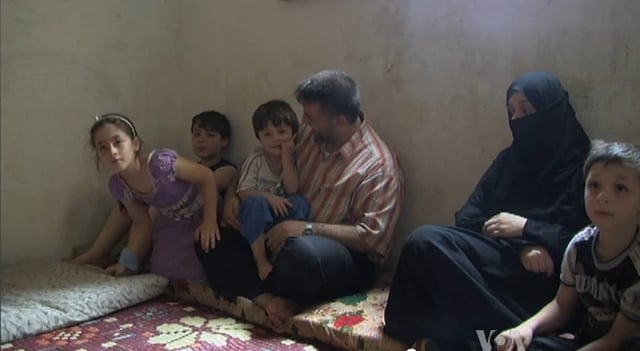
Syrian refugees in Lebanon living in cramped quarters (6 August 2012)
3.8 million have been made refugees.[201] As of 2013, 1 in 3 of Syrian refugees (about 667,000 people) sought safety in Lebanon (normally 4.8 million population).[211] Others have fled to Jordan, Turkey, and Iraq. Turkey has accepted 1,700,000 (2015) Syrian refugees, half of whom are spread around cities and a dozen camps placed under the direct authority of the Turkish Government. Satellite images confirmed that the first Syrian camps appeared in Turkey in July 2011, shortly after the towns of Deraa, Homs, and Hama were besieged.[212] In September 2014, the UN stated that the number of Syrian refugees had exceeded 3 million.[213] According to the Jerusalem Center for Public Affairs, Sunnis are leaving for Lebanon and undermining Hezbollah's status. The Syrian refugee crisis has caused the "Jordan is Palestine" threat to be diminished due to the onslaught of new refugees in Jordan. Greek Catholic Patriarch Gregorios III Laham claims more than 450,000 Syrian Christians have been displaced by the conflict.[214] As of September 2016, the European Union has reported that there are 13.5 million refugees in need of assistance in the country.[215]
Internally displaced
The violence in Syria caused millions to flee their homes. As of March 2015, Al-Jazeera estimate 10.9 million Syrians, or almost half the population, have been displaced.[201]
Casualties
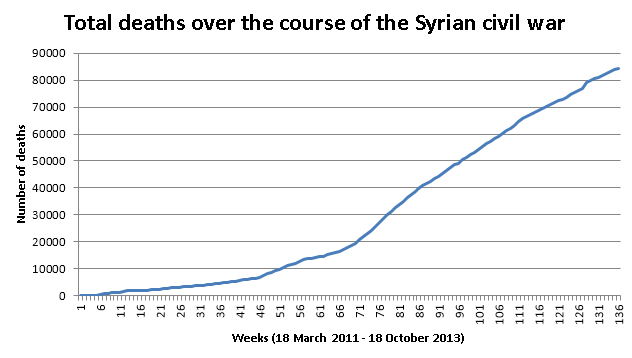
Total deaths over the course of the conflict in Syria (18 March 2011 – 18 October 2013) based on data from the Syrian National Council[216]

Wounded civilians arrive at a hospital in Aleppo, October 2012
On 2 January 2013, the United Nations stated that 60,000 had been killed since the civil war began, with UN High Commissioner for Human Rights Navi Pillay saying "The number of casualties is much higher than we expected, and is truly shocking."[217] Four months later, the UN's updated figure for the death toll had reached 80,000.[218] On 13 June 2013, the UN released an updated figure of people killed since fighting began, the figure being exactly 92,901, for up to the end of April 2013. Navi Pillay, UN high commissioner for human rights, stated that: "This is most likely a minimum casualty figure." The real toll was guessed to be over 100,000.[219][220] Some areas of the country have been affected disproportionately by the war; by some estimates, as many as a third of all deaths have occurred in the city of Homs.[221]
One problem has been determining the number of "armed combatants" who have died, due to some sources counting rebel fighters who were not government defectors as civilians.[222] At least half of those confirmed killed have been estimated to be combatants from both sides, including 52,290 government fighters and 29,080 rebels, with an additional 50,000 unconfirmed combatant deaths.[96] In addition, UNICEF reported that over 500 children had been killed by early February 2012,[223] and another 400 children have been reportedly arrested and tortured in Syrian prisons;[224] both of these claims have been contested by the Syrian government. Additionally, over 600 detainees and political prisoners are known to have died under torture.[225] In mid-October 2012, the opposition activist group SOHR reported the number of children killed in the conflict had risen to 2,300,[226] and in March 2013, opposition sources stated that over 5,000 children had been killed.[227] In January 2014, a report was released detailing the systematic killing of more than 11,000 detainees of the Syrian government.[228]
On 20 August 2014, a new U.N. study concluded that at least 191,369 people have died in the Syrian conflict.[229] The UN thereafter stopped collecting statistics, but a study by the Syrian Centre for Policy Research released in February 2016 estimated the death toll to be 470,000, with 1.9m wounded (reaching a total of 11.5% of the entire population either wounded or killed).[230] A report by the SNHR in 2018 mentioned 82000 victims that had been forcibly disappeared by the Syrian regime, added to 14.000 confirmed deaths due to torture.[231]
Epidemics
The World Health Organization has reported that 35% of the country's hospitals are out of service. Fighting makes it impossible to undertake the normal vaccination programs. The displaced refugees may also pose a disease risk to countries to which they have fled.[232] 400,000 civilians were isolated by the Siege of Eastern Ghouta from April 2013 to April 2018, resulting in acutely malnourished children according to the United Nations Special Advisor, Jan Egeland, who urged the parties for medical evacuations. 55,000 civilians are also isolated in the Rukban refugee camp between Syria and Jordan, where humanitarian relief access is difficult due to the harsh desert conditions. Humanitarian aid reaches the camp only sporadically, sometimes taking three months between shipments.[233][234]
Formerly rare infectious diseases have spread in rebel-held areas brought on by poor sanitation and deteriorating living conditions. The diseases have primarily affected children. These include measles, typhoid, hepatitis, dysentery, tuberculosis, diphtheria, whooping cough and the disfiguring skin disease leishmaniasis. Of particular concern is the contagious and crippling Poliomyelitis. As of late 2013 doctors and international public health agencies have reported more than 90 cases. Critics of the government complain that, even before the uprising, it contributed to the spread of disease by purposefully restricting access to vaccination, sanitation and access to hygienic water in "areas considered politically unsympathetic".[235]
Humanitarian aid

US aid to Syrian opposition forces, May 2013
The conflict holds the record for the largest sum ever requested by UN agencies for a single humanitarian emergency, $6.5 billon worth of requests of December 2013.[236] The international humanitarian response to the conflict in Syria is coordinated by the United Nations Office for the Coordination of Humanitarian Affairs (UNOCHA) in accordance with General Assembly Resolution 46/182.[237] The primary framework for this coordination is the Syria Humanitarian Assistance Response Plan (SHARP) which appealed for US$1.41 billion to meet the humanitarian needs of Syrians affected by the conflict.[238] Official United Nations data on the humanitarian situation and response is available at an official website managed by UNOCHA Syria (Amman).[239] UNICEF is also working alongside these organizations to provide vaccinations and care packages to those in need. Financial information on the response to the SHARP and assistance to refugees and for cross-border operations can be found on UNOCHA's Financial Tracking Service. As of 19 September 2015, the top ten donors to Syria were United States, European Commission, United Kingdom, Kuwait, Germany, Saudi Arabia, Canada, Japan, UAE, and Norway.[240]
The difficulty of delivering humanitarian aid to people is indicated by the statistics for January 2015: of the estimated 212,000 people during that month who were besieged by government or opposition forces, 304 were reached with food.[241] USAID and other government agencies in US delivered nearly $385 million of aid items to Syria in 2012 and 2013. The United States has provided food aid, medical supplies, emergency and basic health care, shelter materials, clean water, hygiene education and supplies, and other relief supplies.[242] Islamic Relief has stocked 30 hospitals and sent hundreds of thousands of medical and food parcels.[243]
Other countries in the region have also contributed various levels of aid. Iran has been exporting between 500 and 800 tonnes of flour daily to Syria.[244] Israel supplied aid through Operation Good Neighbor, providing medical treatment to 750 Syrians in a field hospital located in Golan Heights where rebels say that 250 of their fighters were treated.[245] Israel established two medical centers inside Syria. Israel also delivered heating fuel, diesel fuel, seven electric generators, water pipes, educational materials, flour for bakeries, baby food, diapers, shoes and clothing. Syrian refugees in Lebanon make up one quarter of Lebanon's population, mostly consisting of women and children.[246] In addition, Russia has said it created six humanitarian aid centers within Syria to support 3000 refugees in 2016.[247]
Return of refugees
Another aspect of the post war years will be how to repatriate the millions of refugees. The Syrian government has put forward a law commonly known as "law 10", which could strip refugees of property, such as damaged real estate. There are also fears among some refugees that if they return to claim this property they will face negative consequences, such as forced conscription or prison. The Syrian government has been criticized for using this law to reward those who have supported the government. However, the government denies this and has expressed that it wants the return of refugees from Lebanon.[248][249] In December 2018, it was also reported that the Syrian government has started to seize property under an anti-terrorism law, which is affecting government opponents negatively, with many losing their property. Some people's pensions have also been cancelled.[250]
Peace process and de-escalation zones

Syria peace talks in Vienna, 30 October 2015
During the course of the war, there have been several international peace initiatives, undertaken by the Arab League, the United Nations, and other actors.[251] The Syrian government has refused efforts to negotiate with what it describes as armed terrorist groups.[252] On 1 February 2016, the UN announced the formal start of the UN-mediated Geneva Syria peace talks[253] that had been agreed on by the International Syria Support Group (ISSG) in Vienna. On 3 February 2016, the UN Syria peace mediator suspended the talks.[254] On 14 March 2016, Geneva peace talks resumed. The Syrian government insisted that discussion of Bashar-al-Assad's presidency "is a red line", however Syria's President Bashar al-Assad said he hoped peace talks in Geneva would lead to concrete results, and stressed the need for a political process in Syria.[255]
A new round of talks between the Syrian government and some groups of Syrian rebels concluded on 24 January 24, 2017 in Astana, Kazakhstan, with Russia, Iran and Turkey supporting the ceasefire agreement brokered in late December 2016.[256] The Astana Process talks was billed by a Russian official as a complement to, rather than replacement, of the United Nations-led Geneva Process talks.[256] On 4 May 2017, at the fourth round of the Astana talks, representatives of Russia, Iran, and Turkey signed a memorandum whereby four "de-escalation zones" in Syria would be established, effective of 6 May 2017.[257][258]
On September 18 2019, Russia accused the United States and Syrian rebels of obstructing the evacuation process of a refugee camp in southern Syria.[259]
Destruction and reconstruction
United Nations authorities have estimated that the war in Syria has caused destruction reaching to about $400 billion.[260]
While the war still ongoing, Syrian President Bashar Al-Assad claimed that Syria would be able to rebuild the war-torn country on its own. As of July 2018, the reconstruction is estimated to cost a minimum of US$400 billion. Assad claims to be able to loan this money from friendly countries, Syrian diaspora and the state treasury.[261] Iran has expressed interest in helping rebuild Syria.[262] International donors have been suggested as one financier of the reconstruction.[263] As of November 2018, reports emerged that rebuilding efforts had already started. It was reported that the biggest issue facing the rebuilding process is the lack of building material and a need to make sure the resources that do exist are managed efficiently. The rebuilding effort have so far remained at a limited capacity and has often been focused on certain areas of a city, thus ignoring other areas inhabited by disadvantaged people.[264]
According to a Syrian war monitor, over 120 Churches have been damaged or demolished by all sides in Syrian war since 2011.[265]
War crimes (human rights violations, massacres, rape, chemical weapons)

Victims of the Ghouta chemical attack
According to various human rights organizations and United Nations, human rights violations have been committed by both the government and the rebels, with the "vast majority of the abuses having been committed by the Syrian government".[266]
According to three international lawyers,[267] Syrian government officials could face war crimes charges in the light of a huge cache of evidence smuggled out of the country showing the "systematic killing" of about 11,000 detainees. Most of the victims were young men and many corpses were emaciated, bloodstained and bore signs of torture. Some had no eyes; others showed signs of strangulation or electrocution.[268] Experts said this evidence was more detailed and on a far larger scale than anything else that had emerged from the then 34-month crisis.[269]
UN reported also that "siege warfare is employed in a context of egregious human rights and international humanitarian law violations. The warring parties do not fear being held accountable for their acts." Armed forces of both sides of the conflict blocked access of humanitarian convoys, confiscated food, cut off water supplies and targeted farmers working their fields. The report pointed to four places besieged by the government forces: Muadamiyah, Daraya, Yarmouk camp and Old City of Homs, as well as two areas under siege of rebel groups: Aleppo and Hama.[270][271] In Yarmouk Camp 20,000 residents are facing death by starvation due to blockade by the Syrian government forces and fighting between the army and Jabhat al-Nusra, which prevents food distribution by UNRWA.[270][272] In July 2015, the UN quietly removed Yarmouk from its list of besieged areas in Syria, despite not having been able deliver aid there for four months, and declined to explain why it had done so.[273]
ISIS forces have been accused by the UN of using public executions, amputations, and lashings in a campaign to instill fear. "Forces of the Islamic State of Iraq and al-Sham have committed torture, murder, acts tantamount to enforced disappearance and forced displacement as part of attacks on the civilian population in Aleppo and Raqqa governorates, amounting to crimes against humanity", said the report from 27 August 2014.[274]
Enforced disappearances and arbitrary detentions have also been a feature since the Syrian uprising began.[275] An Amnesty International report, published in November 2015, accused the Syrian government of forcibly disappearing more than 65,000 people since the beginning of the Syrian Civil War.[276] According to a report in May 2016 by the Syrian Observatory for Human Rights, at least 60,000 people have been killed since March 2011 through torture or from poor humanitarian conditions in Syrian government prisons.[277]
In February 2017, Amnesty International published a report which accused the Syrian government of murdering an estimated 13,000 persons, mostly civilians, at the Saydnaya military prison. They said the killings began in 2011 and were still ongoing. Amnesty International described this as a "policy of deliberate extermination" and also stated that "These practices, which amount to war crimes and crimes against humanity, are authorised at the highest levels of the Syrian government."[278] Three months later, the United States State Department stated a crematorium had been identified near the prison. According to the U.S., it was being used to burn thousands of bodies of those killed by the government's forces and to cover up evidence of atrocities and war crimes.[279] Amnesty International expressed surprise at the claims about the crematorium, as the photographs used by the US are from 2013 and they did not see them as conclusive, and fugitive government officials have stated that the government buries those its executes in cemeteries on military grounds in Damascus.[280] The Syrian government denied the allegations.
By July 2012, the human rights group Women Under Siege had documented over 100 cases of rape and sexual assault during the conflict, with many of these crimes believed to have been perpetrated by the Shabiha and other pro-government militias. Victims included men, women, and children, with about 80% of the known victims being women and girls.[281]
On September 11, 2019, the UN investigators said that air strikes conducted by the US-led coalition in Syria have killed or wounded several civilians, denoting that necessary precautions were not taken leading to potential war crimes.[282]
As the violence intensifies in north-west Syria, thousands of women and children are reportedly kept under "inhumane conditions" in a remote camp, said UN-appointed investigators.[283]
Depictions
Films
Ladder to Damascus (2013)
Sniper: Legacy (2014)
Phantom (2015)
The Father (2016)
Insyriated (2017)
Damascus Time (2018)
A Private War (2018)
Documentaries
The Return to Homs (2013)
Red Lines (2014)
Silvered Water, Syria Self-Portrait (2014)
7 Days in Syria (2015)
50 Feet from Syria (2015)
Our War (2016)
Salam Neighbor (2016)
The War Show (2016)
The White Helmets (2016), which won the 2017 Oscar for Best Documentary Short.
The battle for Syria. Sources: TV air footage (video documentary + English subtitles The battle for Syria [341] on YouTube, official video documentary and the official text of the VGTRK).[33] [342]
Syrian diary. Sources: TV air footage (video documentary + English subtitles Syrian diary [343] on YouTube), official video documentary of the VGTRK [34] [344] .
Last Men in Aleppo (2017), nominated for Best Documentary Feature at the 90th Academy Awards.
For Sama (2019)
The Cave (2019)
Video games
Endgame: Syria (2012)
1000 Days of Syria (2014)
Syrian Warfare (2017)
Holy Defence (2018)[284]
See also
American-led intervention in the Syrian Civil War
Cities and towns during the Syrian Civil War
Civil uprising phase of the Syrian Civil War
Foreign involvement in the Syrian Civil War
Hezbollah involvement in the Syrian Civil War
Human rights violations during the Syrian Civil War
Inter-rebel conflict during the Syrian Civil War
Iraqi Civil War (2014–2017)
Iraqi insurgency (2011–2013)
Islamist uprising in Syria from 1976 until 1982
List of aviation shootdowns and accidents during the Syrian Civil War
List of terrorist incidents in Syria
List of armed groups in the Syrian Civil War
List of Syrian defectors
List of wars involving Syria
Northwestern Syria offensive (April–June 2015) ("Battle of Victory")
Refugees of the Syrian Civil War
Rojava conflict (Democratic Federation of Northern Syria) – Kurdish participation in the war
Russian involvement in the Syrian Civil War
Spillover of the Syrian Civil War
Syria chemical weapons program
Syrian Civil War ceasefires
Syrian Civil War peace process
Syrian Democratic Council
Syrian diaspora
Syrian Observatory for Human Rights
Syrian–Turkish border clashes during the Syrian Civil War
Terrorism in Syria
Timeline of the Syrian Civil War
White Helmets (Syrian Civil War)

